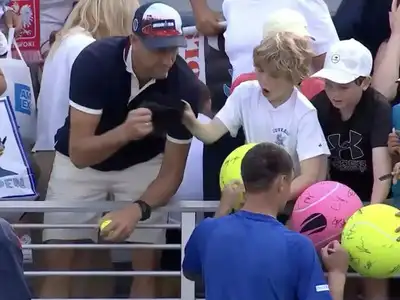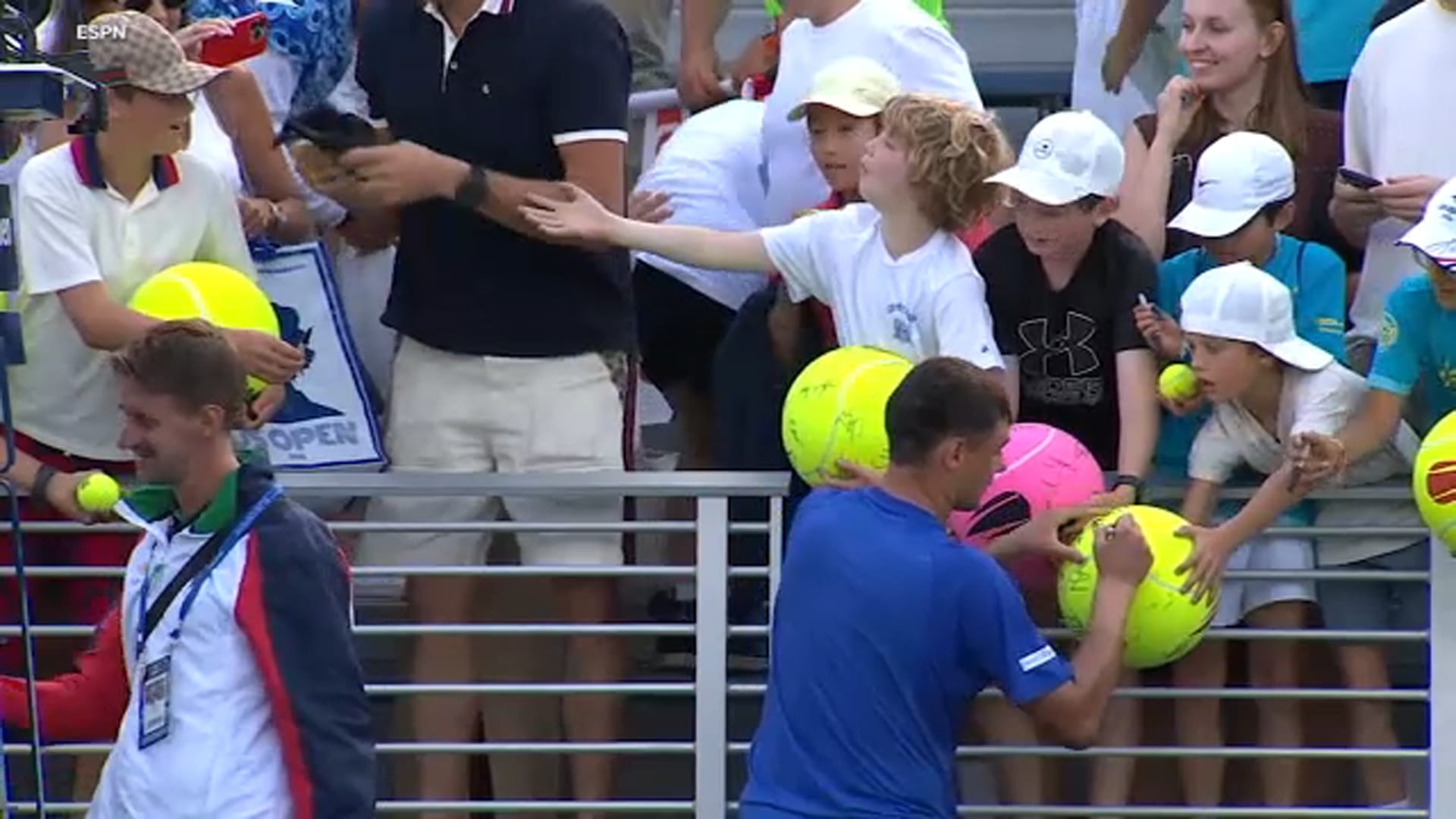US Open 2025: From Viral Villain to Repentant CEO-The Hat Snatching Controversy
It is a story of how a single, fleeting act of thoughtlessness can not only tarnish a reputation but also ignite a worldwide conversation about what it means to be a respectful spectator.

Written by Lavanya, Intern, Allegedly The News
NEW YORK, September 3, 2025
In the aftermath of an exhilarating five-set victory at the US Open, a moment intended to be a heartwarming connection between a victorious athlete and a young fan transformed into a global spectacle of poor sportsmanship, social media outrage, and a CEO’s public apology. The incident, captured on a broadcast camera and rapidly disseminated across the internet, involved a Polish businessman, Piotr Szczerek, snatching a signed tennis cap from a young boy, an act that has since triggered a profound discussion on crowd behavior, corporate reputation, and the unwritten rules of respect in sports.
The Original Sin: A Heartbreaking Moment Caught on Camera
The controversy unfolded on August 30, 2025, following a hard-fought match between Polish tennis star Kamil Majchrzak and Russia’s Karen Khachanov. After clinching the victory, a jubilant Majchrzak made his way to the stands to greet fans and sign autographs. In a gesture of goodwill, he took off his signed, match-worn cap and extended it to a young boy in the front row, later identified only as Brok. As the boy's face lit up with anticipation, a man seated beside him, later identified as Piotr Szczerek, the CEO of the Polish company Drogbruk, swiftly intercepted the cap. He snatched it from the air and, without a moment's hesitation, tucked it into a bag held by the woman next to him, who was his wife.
The camera lingered on the young boy's face. The joy he had felt just seconds before vanished, replaced by a look of bewildered dejection. He reached out, pleading to get the cap back, but was ignored. The man, in a move that further angered viewers, handed the boy the marker pen used for the autograph but kept the prize.
The video clip was raw, unfiltered, and deeply human. It was a perfect storm for social media virality, embodying a clear-cut case of an adult’s greed triumphing over a child’s simple joy. Within hours, the clip was everywhere, shared on X (formerly Twitter), TikTok, and Instagram, where it quickly amassed millions of views. The man became an instant villain.
The Online Avalanche: From Anonymous Man to Identified CEO
The internet's response was swift and unrelenting. In what has become a familiar pattern of online justice, social media users took on the role of digital detectives. They meticulously analyzed the video, cross-referenced stadium seating charts, and used facial recognition to pinpoint the man's identity. Within a day, Piotr Szczerek's name, his company Drogbruk, and his public professional profiles were all over the internet.
The digital backlash was unprecedented. The comment sections of his company's social media pages were flooded with angry messages. His company's Google and GoWork (a Polish jobs search site) ratings were "review-bombed," with thousands of one-star reviews from people who were not customers but simply wanted to express their outrage. Memes mocking his actions proliferated, labeling him "the CEO of stealing dreams" and comparing him to other infamous public figures who had been caught in moments of poor judgment. The backlash was so intense that Szczerek was forced to deactivate his personal social media accounts. The reputational damage was no longer confined to a personal misstep; it had become a full-blown corporate crisis.
The Hero’s Intervention: A Player’s Act of Kindness
As the online firestorm raged, the story found its true hero in the form of the tennis player himself, Kamil Majchrzak. Unaware of the on-court incident at the time it happened, Majchrzak was informed of the viral video. Instead of staying silent, he took to his own social media channels, using his platform to make things right. He posted a public appeal to help him find the young boy. The response was immediate and overwhelming.
Majchrzak was soon in contact with the boy's family. On September 1, 2025, the player shared a heartwarming update. He had met with the boy, Brok, and not only returned the original cap but also gifted him a new signed cap and a bag full of other memorabilia. The images of Majchrzak smiling with a now-beaming Brok, who was proudly wearing his new cap, went viral. It was a powerful and necessary antidote to the initial act of greed, reminding everyone of the true spirit of sportsmanship. Majchrzak’s actions were widely applauded, transforming the narrative from one of disgrace to one of redemption.

The Apology: A Painful and Contradictory Statement
Faced with a mounting public and professional crisis, Piotr Szczerek issued a public apology on his Facebook page. In a carefully worded statement, he expressed "unequivocal" regret and apologized to the boy, his family, the fans, and Majchrzak himself. He attempted to explain his actions, claiming that in the "emotions and joy" of the moment, he believed the cap was being offered to him for his sons, who had previously asked for autographs. He acknowledged that his actions "looked like I deliberately took a souvenir from a child" and admitted that it was a "painful but necessary lesson in humility." He also confirmed that he had personally returned the original hat and apologized to the family.
However, the apology was met with mixed reactions. While some saw it as a genuine admission of guilt, many were quick to point out its contradictory nature. Screenshots of a purported post from Szczerek on a Polish online forum, made before his official apology, had already been circulating. In this post, he allegedly wrote, "Yes, I took it. Life is first-come, first-served. It's just a hat. If you were faster, you would have it." This statement, with its unapologetic and defensive tone, directly contradicted the remorse he expressed in his public apology. For many, this alleged prior statement rendered his formal apology hollow and purely a public relations move to mitigate the damage to his company. The authenticity of his regret was now a matter of public debate, further fueling the online commentary.
Analysis of the Deeper Issue: Crowd Discipline in the Digital Age
The "Hat-Snatching" incident is a microcosm of a much larger issue facing professional sports today: fan behavior in the age of omnipresent cameras. Sporting events have always been a stage for raw emotion, but the pervasiveness of mobile phones and live broadcasts means that every action, no matter how small, can be captured and shared with a global audience in an instant. This creates a new form of accountability.
For sports organizations like the USTA, the incident raises critical questions about their Fan Code of Conduct. While rules exist to prevent unruly or disruptive behavior, this specific incident falls into a gray area of poor sportsmanship that is difficult to police. The event highlights a sense of entitlement that some fans feel, where the desire for a souvenir or a moment of fame outweighs common decency and respect for others, particularly children. Organizers must now consider what, if any, measures can be taken to prevent such incidents in the future. Should fans who exhibit such behavior be identified and banned from future events? How can the spirit of the game be protected when a single bad act can be magnified into a global scandal?
The incident also serves as a potent reminder of the double-edged sword of social media. While it acted as a swift mechanism for justice, bringing a public figure to account and helping to reunite a child with his prize, it also unleashed a torrent of anonymous anger and online shaming. The line between righteous outrage and a form of mob justice is a thin one.
The Final Say: A Call to Action and Self-Reflection
The story of the US Open hat-snatching is not just about a stolen souvenir; it is a lesson in character and consequence. It teaches us that our actions, both big and small, have a ripple effect in an interconnected world. The swift, unmerciful judgment of the online world is a new reality, and those in the public eye, or those who become so in an instant, must navigate it with a new level of awareness.
This incident offers a valuable, if painful, case study for athletes, event organizers, and fans alike. It underscores the power of personal responsibility, the importance of genuine contrition, and the need for a shared code of conduct that goes beyond written rules.
The true resolution came not from the apology, but from the simple, kind act of a professional athlete who showed that sportsmanship extends beyond the court. He reminded us that the community of sports fans can, and should, self-regulate, upholding a standard of respect and decency that ultimately benefits everyone.
What Does This Mean for the Future of Fan Behavior?
Should major sporting events implement a zero-tolerance policy for instances of poor sportsmanship caught on camera, leading to an immediate ban? How can we, as a collective online community, hold people accountable for their actions without resorting to destructive mob justice?
Sources
Times of India, The Guardian, Associated Press, NDTV, and other verified public footage.




